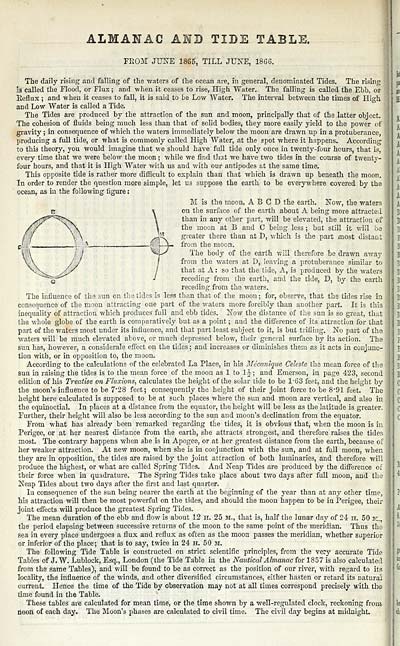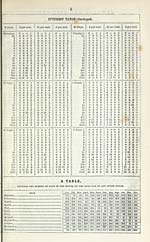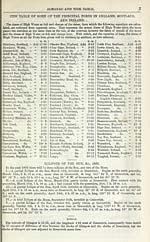Download files
Complete book:
Individual page:
Thumbnail gallery: Grid view | List view

ALMANAC AWB TIDE TABLE.
FSOM JUXE 1865, TILL JUNE, 1866.
The daily rising and falling of the waters of the ocean are, in general, denominated Tides. The rising
m called the Flood, or Flux ; and when it ceases to rise, High Water. The falling is called the Ebb, or
Eeflux ; and when it ceases to fall, it is said to be Low Water. The interval between the times of High
and Low Water is called a Tide.
The Tides are produced by the attraction of the sun and moon, principally that of the latter object.
The cohesion of fluids being much less than that of solid bodies, thej' more easily yield to the power of
gravity ; in consequence of which the waters immediately below the moon are drawn up in a protuberance,
producing a full tide, or what is commonly called High Water, at the spot where it happens. According
to this theory, you would imagine that we should have full tide only once in twenty-four hours, that is,
every time that we were below the moon ; while we find that we have two tides in the course of twenty-
four hours, and that it is High Water with us and with our antipodes at the same time.
This opposite tide is rather more difficult to explain than that which is di-awn up beneath the moon.
In order to render the question more simple, let us suppose the earth to be everywhere covered by the
ocean, as in the following figure :
M is the moon, A B C D the earth. Now, the waters
on the surface of the earth about A being more attracted
than in any other part, will be elevated, the attraction of
the moon at B and C being less ; but still it will be
greater there than at D, which is the part most distant
from the moon.
The body of the earth will therefore be drawn away
from the waters at D, leaving a protuberance similar to
that at A : so that the tide. A, is produced by the waters
receding from the earth, and the tide, D, by the earth
receding from the waters.
The influence of the sun on the tides is less than that of the moon; for, obsei-ve, that the tides rise in
consequence of the moon attracting one part of the waters more forcibly than another part. It is this
inequalitj' of attraction which produces full and ebb tides. Now the distance of the sun is so great, that
the whole globe of the earth is comparatively but as a point ; and the difference of its attraction for that
part of the waters most under its influence, and that part least subject to it, is but trifling. No part of the
waters will be much elevated above, or much depressed below, their gencval surface by its action. The
sun has, however, a considerale effect on the tides; and increases or diminishes them as it acts in conjunc-
tion with, or in opposition to, the moon.
According to the calculations of the celebrated La Place, in his Me'canique Celeste the mean force of the
sun in raising the tides is to the mean force of the moon as 1 to 1-J ; and Emerson, in page 423, second
edition of his Treatise on Fluxions, calculates the height of the solar tide to be 1-63 feet, and the height by
the moon's influence to be 7-28 feet; consequently the height of their joint force to be 8'91 feet. The
height here calculated is supposed to be at such places where the sun and moon are vertical, and also in
the equinoctial. In places at a distance from the equator, the height will be less as the latitude is greater.
Further, their height will also be less according to the sun and moon's declination from the equator.
From what has already been remarked regarding the tides, it is obvious that, when the moon is in
Perigee, or at her nearest distance from the earth, she attracts strongest, and therefore raises the tides
most. The contrary happens when she is in Apogee, or at her greatest distance from the earth, because Oi
her weaker attraction. At new moon, when she is in conjunction with the sun, and at full moon, when
they are in opposition, the tides are raised by the joint attraction of both luminaries, and therefore will
produce the highest, or what are called Spring Tides. And Neap Tides are produced by the difference of
their force when in quadrature. The Spring Tides take place about two days after full moon, and the
Neap Tides about two days after the first and last quarter.
In consequence of the sun being nearer the earth at the beginning of the year than at any other time,
his attraction will then be most powerful on the tides, and should the moon happen to be in Perigee, their
joint effects will produce the greatest Spring Tides.
The mean duration of the ebb and flow is about 12 h. 25 m., that is, half the lunar day of 24 h. 50 k.
the period elapsing between successive returns of the moon to the same point of the meridian. Thus the
sea in every place undergoes a flux and reflux as often as the moon passes the meridian, whether superior
or inferior of the place; that is to say, twice in 24 h. 50 m.
The following Tide Table is constructed on strict scientific principles, from the verj' accurate Tide
Tables of J. W. Lublock, Esq., London (the Tide Table in the Nautical Almanac for 1857 is also calculated
from the same Tables), and will be found to be as correct as the position of our river, with regard to its
locality, the influence of the winds, and other diversified circumstances, either hasten or retard its natura:
current. Hence the time of the Tide by observation may not at all times correspond precisely -Hith the
time found in the Table.
These tables are calculated for mean time, or the time shown by a well-regulated clock, reckoning from
noon of each day. The Moon's phases are calculated to civil time. The civil day begins at midnight.
FSOM JUXE 1865, TILL JUNE, 1866.
The daily rising and falling of the waters of the ocean are, in general, denominated Tides. The rising
m called the Flood, or Flux ; and when it ceases to rise, High Water. The falling is called the Ebb, or
Eeflux ; and when it ceases to fall, it is said to be Low Water. The interval between the times of High
and Low Water is called a Tide.
The Tides are produced by the attraction of the sun and moon, principally that of the latter object.
The cohesion of fluids being much less than that of solid bodies, thej' more easily yield to the power of
gravity ; in consequence of which the waters immediately below the moon are drawn up in a protuberance,
producing a full tide, or what is commonly called High Water, at the spot where it happens. According
to this theory, you would imagine that we should have full tide only once in twenty-four hours, that is,
every time that we were below the moon ; while we find that we have two tides in the course of twenty-
four hours, and that it is High Water with us and with our antipodes at the same time.
This opposite tide is rather more difficult to explain than that which is di-awn up beneath the moon.
In order to render the question more simple, let us suppose the earth to be everywhere covered by the
ocean, as in the following figure :
M is the moon, A B C D the earth. Now, the waters
on the surface of the earth about A being more attracted
than in any other part, will be elevated, the attraction of
the moon at B and C being less ; but still it will be
greater there than at D, which is the part most distant
from the moon.
The body of the earth will therefore be drawn away
from the waters at D, leaving a protuberance similar to
that at A : so that the tide. A, is produced by the waters
receding from the earth, and the tide, D, by the earth
receding from the waters.
The influence of the sun on the tides is less than that of the moon; for, obsei-ve, that the tides rise in
consequence of the moon attracting one part of the waters more forcibly than another part. It is this
inequalitj' of attraction which produces full and ebb tides. Now the distance of the sun is so great, that
the whole globe of the earth is comparatively but as a point ; and the difference of its attraction for that
part of the waters most under its influence, and that part least subject to it, is but trifling. No part of the
waters will be much elevated above, or much depressed below, their gencval surface by its action. The
sun has, however, a considerale effect on the tides; and increases or diminishes them as it acts in conjunc-
tion with, or in opposition to, the moon.
According to the calculations of the celebrated La Place, in his Me'canique Celeste the mean force of the
sun in raising the tides is to the mean force of the moon as 1 to 1-J ; and Emerson, in page 423, second
edition of his Treatise on Fluxions, calculates the height of the solar tide to be 1-63 feet, and the height by
the moon's influence to be 7-28 feet; consequently the height of their joint force to be 8'91 feet. The
height here calculated is supposed to be at such places where the sun and moon are vertical, and also in
the equinoctial. In places at a distance from the equator, the height will be less as the latitude is greater.
Further, their height will also be less according to the sun and moon's declination from the equator.
From what has already been remarked regarding the tides, it is obvious that, when the moon is in
Perigee, or at her nearest distance from the earth, she attracts strongest, and therefore raises the tides
most. The contrary happens when she is in Apogee, or at her greatest distance from the earth, because Oi
her weaker attraction. At new moon, when she is in conjunction with the sun, and at full moon, when
they are in opposition, the tides are raised by the joint attraction of both luminaries, and therefore will
produce the highest, or what are called Spring Tides. And Neap Tides are produced by the difference of
their force when in quadrature. The Spring Tides take place about two days after full moon, and the
Neap Tides about two days after the first and last quarter.
In consequence of the sun being nearer the earth at the beginning of the year than at any other time,
his attraction will then be most powerful on the tides, and should the moon happen to be in Perigee, their
joint effects will produce the greatest Spring Tides.
The mean duration of the ebb and flow is about 12 h. 25 m., that is, half the lunar day of 24 h. 50 k.
the period elapsing between successive returns of the moon to the same point of the meridian. Thus the
sea in every place undergoes a flux and reflux as often as the moon passes the meridian, whether superior
or inferior of the place; that is to say, twice in 24 h. 50 m.
The following Tide Table is constructed on strict scientific principles, from the verj' accurate Tide
Tables of J. W. Lublock, Esq., London (the Tide Table in the Nautical Almanac for 1857 is also calculated
from the same Tables), and will be found to be as correct as the position of our river, with regard to its
locality, the influence of the winds, and other diversified circumstances, either hasten or retard its natura:
current. Hence the time of the Tide by observation may not at all times correspond precisely -Hith the
time found in the Table.
These tables are calculated for mean time, or the time shown by a well-regulated clock, reckoning from
noon of each day. The Moon's phases are calculated to civil time. The civil day begins at midnight.
Set display mode to: Large image | Transcription
Images and transcriptions on this page, including medium image downloads, may be used under the Creative Commons Attribution 4.0 International Licence unless otherwise stated. ![]()
| Scottish Post Office Directories > Towns > Glasgow > Post-Office annual Glasgow directory > 1865-1866 > (42) |
|---|
| Permanent URL | https://digital.nls.uk/84371864 |
|---|
| Description | Directories of individual Scottish towns and their suburbs. |
|---|
| Description | Around 700 Scottish directories published annually by the Post Office or private publishers between 1773 and 1911. Most of Scotland covered, with a focus on Edinburgh, Glasgow, Dundee and Aberdeen. Most volumes include a general directory (A-Z by surname), street directory (A-Z by street) and trade directory (A-Z by trade). |
|---|


